This article explores the benefits of marine biology internships and features examples of GVI's marine conservation programs. Learn more!
Petrina Darrah
Posted: May 15, 2025

Rayleen Hillman
Posted: January 27, 2021
Volunteering in Greece with sea turtles has more to it than wildlife conservation. Each day volunteers have an important task assigned to support the group’s efforts. Here is what to expect on a typical day, saving sea turtles.
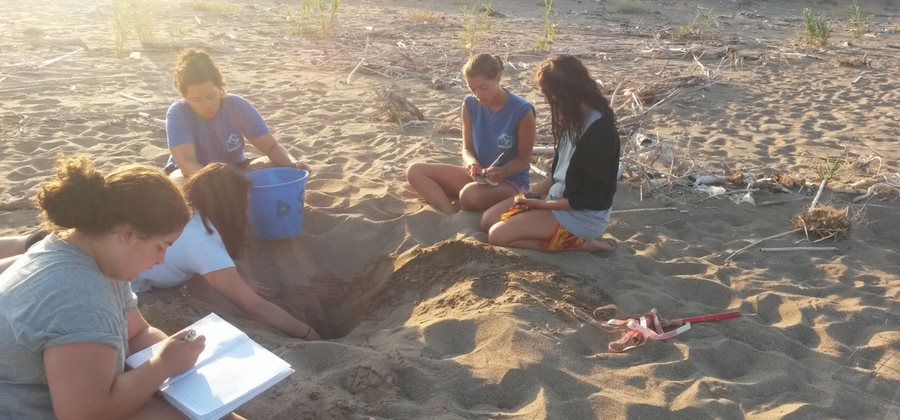
Disclaimer: All images in this blog taken pre COVID-19.
It’s early. The night time crickets are still chirping before the songbirds greet the orange-hued sunrise. It is the perfect hour to start surveying the sea turtle nests on the beach. Your thoughtful camp leader prepares a steaming cup of coffee for you as you grab the supplies. The backpack will have the field notes, pens and some water. Everyone will need to carry something: cut wire fence panels, hammers and bamboo pieces. No one else in the campsite is awake yet and as you step onto the beach, the first rays of sunlight are streaked across the sky. With the waves gently lapping up the beach, the small group of early risers start to move down the beach, checking the sea turtle nests.
As you find a nest, you check that it is still secure from predators. If not, you will use the supplies to strengthen the nest’s protective elements. The main predators on the beach for sea turtles in Greece are stray dogs. The wire fencing protects the nest from being dug up by the dogs.
Some nests have manmade gully-like runways from the nest to the sea. These sometimes need building or rebuilding and the handmade beach mat ‘walls’ hammered in place to support them. Nests are also observed for any signs of hatched sea turtles by checking for tracks in the sand. Counting how many tracks meet the sea is noted in the field research book and used to estimate successful hatchlings reaching the ocean.
As the season wears on, you may also be digging up a hatched nest and counting the left behind shells to guestimate how many turtles the nest could have yielded. Collecting this information is vital for providing valuable field statistics to support ongoing sea turtle conservation in the area.
Surveying is done for the day, you will head back to camp just as the other volunteers are starting to rise and shine. Over breakfast is a great time to update your fellow volunteers what you found that morning. You will be done for the day too which means you can grab your favourite book, swimsuit and towel and go relax on the beach or one of the hammocks at basecamp.
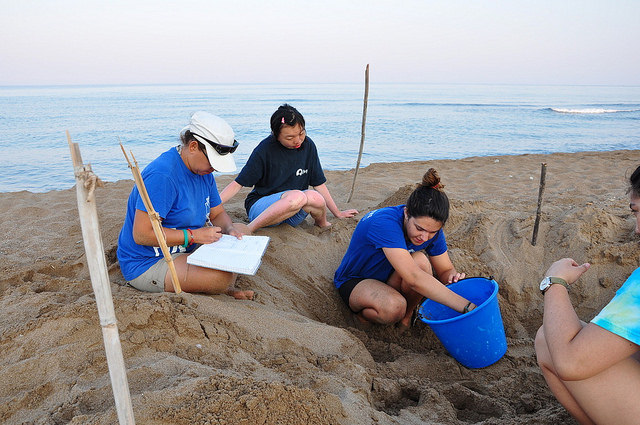
Mid-morning, the dappled shade of an olive tree is the perfect spot to spend time together making turtle nest tunnel runs. Turtle nest runs are strips of donated beach mats collected at the beach hut from visitors. These strips are attached to pieces of bamboo so they resemble a roughly 20cm high fence panel. The fence panels are rolled up for the beach surveyors to take with them each morning. They are hammered into the sand from the nest all the way down to the sea and help the turtles stay safely on track to their watery destination.
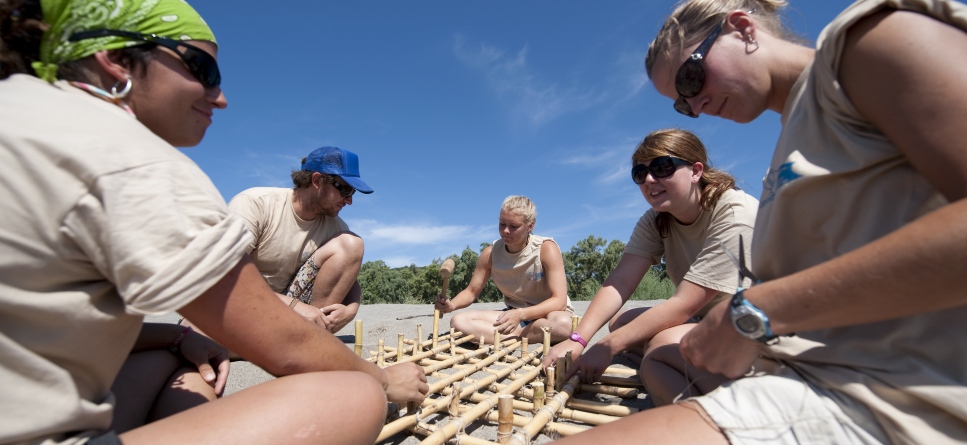
If you are unable to spend long periods of time sitting on the floor, the task can be done from a chair. It is a fairly repetitive task but as you construct the runs, chatter amongst the volunteers is easy. Time flies when you’re having fun. Everyone is from somewhere different and this task, amongst a small group of you, is great for learning about where they come from and why they chose to volunteer with sea turtles in Greece.
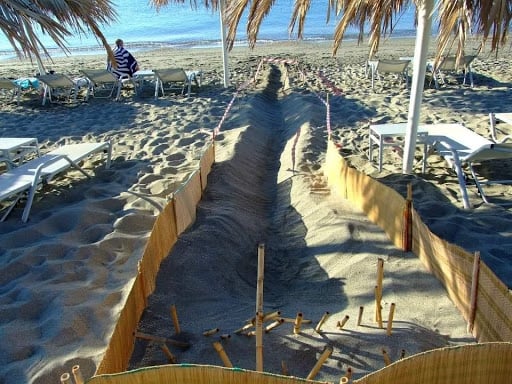
Our partner in Greece, Archelon, typically has a beach hut that needs manning with a morning and afternoon shift. The little hut, with its weathered wooden shack-like walls, has enough room for two volunteers. Protected from the sweltering Greek summer sun, your job is to talk to visitors about the vital sea turtle conservation work on the beach. It is also where we collect donated beach mats. These mats are what we recycle into the turtle tunnel runs.
Sometimes there is a ‘Baywatch’ moment to the shift as a beachgoer runs up to tell you that a turtle hatchling needs saving. Other times it’s like the last lesson at school and it seems like the bell will never ring. These are also the best moments for quality time with your fellow volunteer. You are all there for the same purpose: wildlife conservation. Yet you all come from different places and backgrounds before volunteering abroad with GVI. Being confined together in the hut fosters an easy atmosphere for swapping life stories and making lifelong friends.
Don’t be surprised if your other volunteer partners pop by and say hello, sit with you awhile or bring you refreshing iced coffees or frosty sodas. This is your new volunteer family after all and a sense of community is inevitable.
Turtle camp can have as many as 20 volunteers living in it. Each one is responsible for keeping their tent area clean and tidy and doing their own laundry. Shared areas however will need daily cleaning. Pop on some of your favourite music for some positive vibes and get stuck in. This could be washing up the plates from breakfast and dinner, putting away the food, sweeping the floors and wiping down tables.
This is also a useful time to take stock on supplies and add any food needs to the shopping list. At the same time, checking that no naughty critters have accessed the food storage. This is camping after all. Many hands make light work so as a team you will be done in no time. It won’t be long until you can flop into a free hammock with a book or head down to the beach for your fill of sun, sea and sand.
Do not worry. This is not an episode of ‘MasterChef’! If you have never cooked before this is a safe and friendly way to start exploring your inner chef. You will be paired with another volunteer and together you will plan dinner for up to 20 people. Ask for help when you need it.
Using local produce is a great way to experience your volunteer country. Plan ahead and you could get some local produce at the next shopping trip to compliment your cheffing efforts. Check with the camp leader for known allergies and dietary requirements too. That way you can be inclusive of everyone. Dinner is usually a communal affair. All the volunteers gather to talk about their day, share their learnings and swap stories. As they wolf down your tasty meal the camp will be buzzing with shared laughter. Sit back and enjoy how your efforts brought people together.
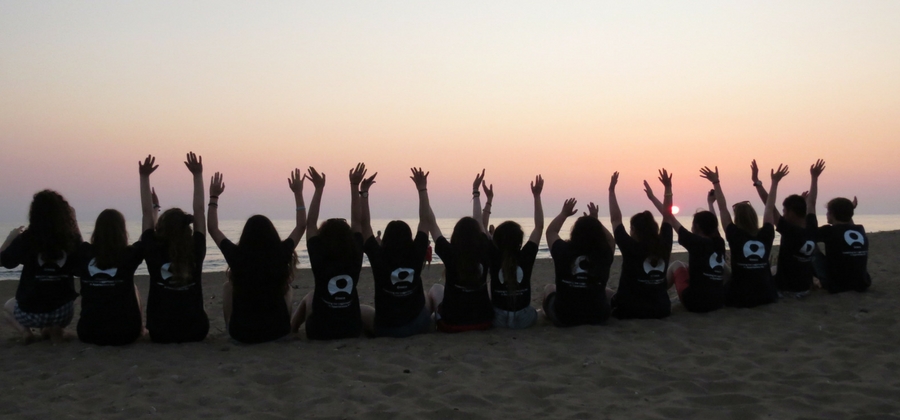
Basecamp is the heart of the volunteer experience. It is your home with your volunteer family during your stay. Each task helps build this new community of supportive friends. Every day brings opportunities to learn from each other whilst conducting invaluable wildlife conservation work. It is this tapestry of volunteer life that creates unforgettable good memories of volunteering in Greece. Saving sea turtles is not just about wildlife conservation. It is also about learning from each other, community, and supporting each other every day. Come and join a community of volunteers at our sea turtle conservation program in Greece and find out for yourself.
Disclaimer: All images in this blog were taken pre COVID-19.
This article explores the benefits of marine biology internships and features examples of GVI's marine conservation programs. Learn more!
Petrina Darrah
Posted: May 15, 2025